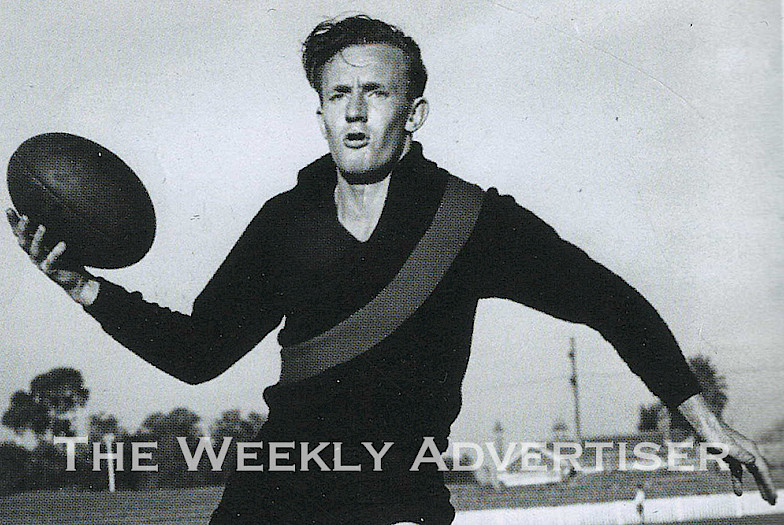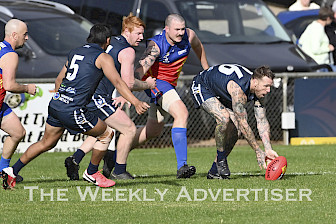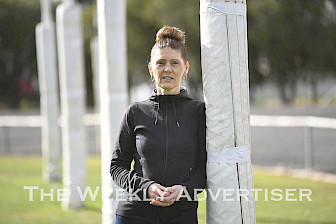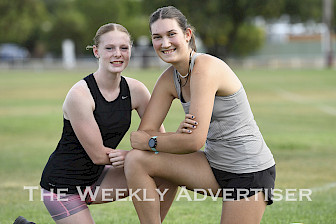He is also a life member of Edenhope-Apsley Saints, and was a three-time premiership player for Casterton.
The Saints will informally mark Burgess’ milestone after team selections are announced tonight, at about 8pm.
Seventy years ago, on April 24, 1954, a speedy youngster from Apsley made his debut for Essendon in front of 23,000 people at Windy Hill.
When Lance Mann was ruled out due to a knee injury, Burgess, a 19-year-old shy, country boy stepped up to play his first senior game.
He had grown up listening to his Essendon heroes on the wireless - Reynolds, Hutchie and Coleman among them, while he played in a cross border league footy.
Burgess had won a premiership with Apsley in 1952 and was runner-up league best and fairest in 1953.
He was spotted by Essendon and after playing one game on permit in 1953, and moved to Essendon in 1954 to try his hand at the club.
Burgess was nervous and to this day, believes he did not play well on the half-forward flank.
“Reynolds gave me three games to prove myself,” he said.
In round four, he was moved to the wing in place of Peter O’Sullivan.
Burgess was such a talented rookie that before season’s end he was filling in for Jack Clarke in the centre during his Victorian commitments.
Burgess impressed selectors, won the best first year player award and he went on to play almost 100 games on the wing.
One of the greats
The line-up of Sewell-Clarke-Burgess would become one of the most iconic centrelines in the league and arguably the greatest in Essendon’s history.
Burgess was named as number 13 in the Champions of Essendon; named in Essendon’s Team of the Century; and is a member of Essendon’s Hall of Fame.
He won club best and fairest in 1957 and 1960, played seven times for Victoria and was named all Australian in 1958.
Burgess was meticulous in his preparation for each game. His boots were polished to remove all traces of the ‘Merri Creek mud’.
He spent 15-20 minutes by himself, thinking how he would beat his direct opponent.
“I always believed that if I allowed him to get the first kick, he would be the best player. If I got the first kick, away we would go,” Burgess said.
Exceptional opposition players like Melbourne’s Brian Dixon, and Collingwood’s Thorold Merrett and Bill Serong rate him as one of the hardest opponents they had to shut down, despite the fact he never once threw a punch or broke the gentleman’s code of conduct.
“My, he was tough,” Dixon recalled.
Burgess had an ability to read the play and slow time down. His drop kicks hit the forwards on the chest, hard, every time.
Kevin Merrett, of Apsley, nephew to Collingwood’s Merrett said he had a magnificent kick.
“I remember at footy training at Apsley, we were only kids. He could stand in the centre. he would stab kick, sandshoes in winter. I would go home, red as red where it hit you,” Merrett said.
Unselfish
Burgess played unselfish football, perhaps robbing himself of a few Brownlow votes.
Despite being a small player at 175 centimetres, he played big.
Burgess had a massive stride and left an even bigger impression. For those who never experienced the thrill of watching Burgess play, some believe that Collingwood’s Scott Pendlebury is a modern day footballer who most matches his style.
Essendon almost lost Burgess in his second season when homesickness overcame him.
“It wasn’t that bloody easy, I didn’t know anything. You had to break in down there and get to know people,” Burgess said.
But he returned with a new attitude and won the club’s most improved that year.
Burgess played in the 1957 finals while his battle with the measles was hidden from the press. He also recalls one time where he almost ‘drowned under a pack at Footscray on a very wet day’.
In 1959, he moved into the centre. He didn’t waste a minute of the opportunity and clocked up another 24 games.
In 1960, Burgess played arguably his best year, winning club ‘best and fairest’ and the press named him ‘best on’ in his final game.
But, back in the 1950s and 60s players were not paid much, taking home around £6 – $240 in today’s equivalent – per game, and so despite being one of the greats of the game, at age 26 Burgess was lured back to the bush.
He won three premierships as a player coach at Casterton, where he earnt more in his first year than all seven at Essendon.
Literally thousands of fans turned up to watch him and his talented team play.
In 1963, Burgess was still recovering from a dislocated shoulder, sustained in an Interleague match, when he kicked seven goals in the grand final.
In 1964, Burgess returned to his home club of Apsley where he won the Kowree Naracoorte League Mail Medal in his first year and helped the team to a premiership in 1965.
Burgess hung up his perfectly polished boots in 1966 and spent the next 60 years giving back to the sport and to the community.
“I never put as much into football as I got out of that football. I can tell you that now,” he said, attributing much of his success to the unwavering support of his wife Marg and their family.
Burgess now lives in Edenhope and will celebrate his milestone enjoying a quiet drink with friends and family.
Editor’s note: In 1954, Jimmy Caldow from Edenhope travelled with Burgess to train with Essendon. While Caldow did not make the cut, he did have plenty of talent and passion. Seventy years later, Caldow ‘s son Clayton and grandson Angus are working with local author Toni Domaschenz to write a book about the great Reg Burgess.
The trio are still looking for stories, photos and videos. Anyone who can assist can call phone Toni on 0422 591 998, Clayton on 0407 356 558 or Angus on 0479 137 751.
Burgess also features in a book by Ballarat authors Michael Kearney and Phil Hoey called ‘Coley’s Champs’ in which they speculate in one chapter ‘What If?’ Burgess had still been playing in 1962. Coley’s Champs is available for sale at Edenhope Post Office.






